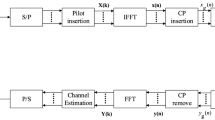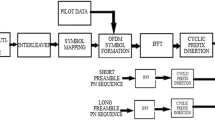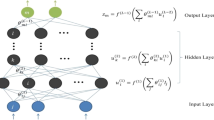Abstract
Orthogonal Frequency Division Multiplexing (OFDM) systems are prone to signal corruption caused by strong and frequent impulses, which can be further exacerbated by multipath fading. Recent evolutions highlight the efficacy of a deep neural network (DNN) receiver in intrinsically estimating channel state information and recovering data explicitly, even without presuming the signal-to-noise ratio (SNR) level. However, the conventional DNN-based receiver, trained on data generated from computer simulations with WINNER II channel model and additive white Gaussian noise (AWGN), is susceptible to substantial performance degradation when subject to impulse noise. To address this challenge, this paper proposes fine-tuning the DNN model using impulse noise-laced data samples during subsequent training. The proposed method aims to enhance representation learning and improve the robustness of the receiver against impulse noise. The efficacy of the DNN-based receiver is assessed by comparing its bit error rate (BER) performance to that of a compressive sensing-based receiver, enabled by the consensus alternating direction method of multipliers (ADMM). Remarkably, the proposed DNN-based receiver achieves BER performance comparable to the clipping-featured receiver, which requires knowledge of the SNR value, an assumption relaxed by our enhanced DNN approach. Furthermore, extensive simulations demonstrate the promising robustness of the deep learning-based approach against impulse noise model mismatches between training and testing scenarios.








Similar content being viewed by others
Data Availability
Data are available upon request.
References
Al-Naffouri, T. Y., Quadeer, A. A., & Caire, G. (2014). Impulse noise estimation and removal for OFDM systems. IEEE Transactions on Communications, 62(3), 976–989.
Barazideh, R., Niknam, S., & Natarajan, B. (2019). Impulsive noise detection in OFDM-based systems: A deep learning perspective. In Proceedings of the IEEE 9th annual computing and communication workshop and conference (CCWC 2019) (pp. 937–942 ).
Boyd, S., Parikh, N., Chu, E., Peleato, B., & Eckstein, J. (2011). Distributed optimization and statistical learning via the alternating direction method of multipliers. Foundations and Trends in Machine Learning, 3, 1–122.
Candes, E. J., & Randall, P. A. (2008). Highly robust error correction by convex programming. IEEE Transactions on Information Theory, 54(7), 2829–2840.
Ferrer-Coll, J., Slimane, S., & Chilo, J. E. A. (2015). Detection and suppression of impulsive noise in OFDM receiver. Wireless Personal Communications, 85, 2245–2259. https://doi.org/10.1007/s11277-015-2902-4
Fesl, B., Turan, N., Joham, M., & Utschick, W. (2023). Learning a Gaussian mixture model from imperfect training data for robust channel estimation. IEEE Wireless Communications Letters, 12(6), 1066–1070.
Gao, X., Jin, S., Wen, C. K., & Li, G. Y. (2018). ComNet: Combination of deep learning and expert knowledge in OFDM receivers. IEEE Communications Letters, 22(12), 2627–2630.
Ghosh, M. (1996). Analysis of the effect of impulse noise on multicarrier and single carrier QAM systems. IEEE Transactions on Communications, 44(2), 145–147.
Glorot, X., & Bengio, Y. (2010). Understanding the difficulty of training deep feedforward neural networks. In Proceedings of the international conference on artificial intelligence and statistics (AISTATS) (pp. 249–256).
Gonzalez, J. G., Paredes, J. L., & Arce, G. R. (2006). Zero-order statistics: A mathematical framework for the processing and characterization of very impulsive signals. IEEE Transactions on Signal Processing, 54(10), 3839–3851.
Goodfellow, I. J., Shlens, J., & Szegedy, C. (2014). Explaining and harnessing adversarial examples. arXiv:1412.6572
Grant, M., & Boyd, S. (2014). CVX: Matlab software for disciplined convex programming, version 2.1. http://cvxr.com/cvx
He, Y., Zou, C., Li, D., Yao, R., Yang, F., & Song, J. (2023). Adaptive impulsive noise suppression: A deep learning-based parameters estimation approach. IEEE Transactions on Broadcasting, 69(2), 505–515.
Kim, H., Oh, S., & Viswanath, P. (2020). Physical layer communication via deep learning. IEEE Journal on Selected Areas in Information Theory, 1(1), 5–18.
Kingma, D., & Ba, J. (2015). Adam: A method for stochastic optimization. In Proceedings of the 3rd international conference on learning representations.
Kyosti, P., et al. (2007). Winner II channel models. Eur. Commission, Brussels, Belgium, Tech. Rep. D1.1.2 IST-4-027756-WINNER.
Li, J., Zhang, Z., Wang, Y., He, B., Zheng, W., & Li, M. (2023). Deep learning-assisted OFDM channel estimation and signal detection technology. IEEE Communications Letters, 27(5), 1347–1351.
Li, X., Han, Z., Yu, H., Yan, L., & Han, S. (2022). Deep learning for OFDM channel estimation in impulsive noise environments. Wireless Personal Communications, 125, 2947–2964. https://doi.org/10.1007/s11277-022-09693-z
Mandal, A. K., & De, S. (2023). A novel learning-based estimation scheme for communication over impulsive noise channels. IEEE Wireless Communications Letters, 12(7), 1154–1158.
Middleton, D. (1983). Canonical and quasi-canonical probability models of Class A interference, (pp. 76–106).
Mulla, M., Rizaner, A., & Ulusoy, A. (2022). Fuzzy logic based decoder for single-user millimeter wave systems under impulsive noise. Wireless Personal Communications, 124, 1883–1895. https://doi.org/10.1007/s11277-021-09435-7
Nikias, C. L., & Shao, M. (1995). Signal processing with alpha-stable distributions and applications. Wiley.
O’Shea, T. J., & Hoydis, J. (2017). An introduction to deep learning for the physical layer. IEEE Transactions on Cognitive Communications and Networking, 3(4), 563–575.
Selim, B., Alam, M. S., Evangelista, J. V. C., Kaddoum, G., & Agba, B. L. (2020). NOMA-based IoT networks: Impulsive noise effects and mitigation. IEEE Communications Magazine, 58(11), 69–75.
Selim, B., Alam, M. S., Kaddoum, G., AlKhodary, M. T., & Agba, B. L. (2020). A deep learning approach for the estimation of Middleton Class-A impulsive noise parameters. In IEEE international conference on communications (pp. 1–6).
Shi, J., Lu, A. A., Zhong, W., Gao, X., & Li, G. Y. (2023). Robust WMMSE precoder with deep learning design for massive MIMO. IEEE Transactions on Communications, 71(7), 3963–3976.
Tsai, T. R., & Tseng, D.-F. (2008). Subspace algorithm for blind channel identification and synchronization in single-carrier block transmission systems. Signal Processing, 88(2), 296–306.
Tseng, D.-F., Han, Y. S., Mow, W. H., Chang, L. C., & Vinck, A. J. H. (2012). Robust clipping for OFDM transmissions over memoryless impulsive noise channels. IEEE Communications Letters, 1110–1113.
Tseng, D.-F., & Lin, C. S. (2021). A study of neural network receivers in OFDM systems subject to memoryless impulse noise. In Proceedings of the 30th Wireless and Optical Communications Conference (WOCC2021) (pp. 16–20).
Tseng, S.-M., Hsu, W. C., & Tseng, D.-F. (2022). Deep learning based decoding for polar codes in Markov Gaussian memory impulse noise channels. Wireless Personal Communications, 122, 737–753. https://doi.org/10.1007/s11277-021-08923-0
Xiao, M., et al. (2017). Millimeter wave communications for future mobile networks. IEEE Journal on Selected Areas in Communications, 35(9), 1909–1935.
Ye, H., Li, G. Y., & Juang, B. (2018). Power of deep learning for channel estimation and signal detection in OFDM systems. IEEE Wireless Communications Letters, 7(1), 114–117.
Zhao, H., Yang, C., Xu, Y., Ji, F., Wen, M., & Chen, Y. (2023). Model-driven based deep unfolding equalizer for underwater acoustic OFDM communications. IEEE Transactions Vehicular Technology, 72(5), 6056–6067.
Acknowledgements
The authors acknowledged the research funding received from the Ministry of Science and Technology (MOST) of Taiwan for the major research projects.
Funding
This work was supported by the Ministry of Science and Technology (MOST) of Taiwan under grant no. MOST 109-2221-E-011-119-, MOST 110-2221-E-011-066- and MOST 111-2221-E-011-060 -.
Author information
Authors and Affiliations
Contributions
D-FT, the corresponding author, contributed to the study conception, performed system design and experiments, and wrote the first draft of the manuscript. C-SL conducted computer simulations. S-MT made significant contributions to the analysis and conception of the study. All authors read and approved the final manuscript.
Corresponding author
Ethics declarations
Conflict of interest
The authors declare that they have no competing interests.
Ethical Approval and Consent to Participate
This article does not contain any studies with human participants or animals performed by any of the authors and all authors have read and understood the provided information.
Consent for Publication
This article does not contain any images or videos to get permission and all authors gave consent for publication.
Additional information
Publisher's Note
Springer Nature remains neutral with regard to jurisdictional claims in published maps and institutional affiliations.
Rights and permissions
Springer Nature or its licensor (e.g. a society or other partner) holds exclusive rights to this article under a publishing agreement with the author(s) or other rightsholder(s); author self-archiving of the accepted manuscript version of this article is solely governed by the terms of such publishing agreement and applicable law.
About this article
Cite this article
Tseng, DF., Lin, CS. & Tseng, SM. Impulse Noise Suppression by Deep Learning-Based Receivers in OFDM Systems. Wireless Pers Commun 134, 557–580 (2024). https://doi.org/10.1007/s11277-024-10919-5
Accepted:
Published:
Issue Date:
DOI: https://doi.org/10.1007/s11277-024-10919-5




